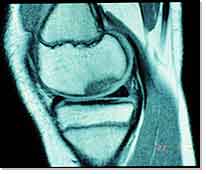A novel scaffold could improve cartilage repair
Feb 6, 2007 - 12:21:19 PM
, Reviewed by: Dr. Rashmi Yadav
|
|
|
"By taking a synthetic material that already has the properties of cartilage and combining it with living cells, we can build a human tissue that can be integrated rapidly into the body, representing a new approach in the field of tissue engineering."
|
|
Key Points of this article
|
|
Current therapies to repair cartilage damage are not effective.
|
|
The only bioengineering approach to such joint repair involves removing cartilage cells from patients and then "growing" them in a laboratory to form new cartilage, which takes several months.
|
|
The fabric scaffold used in the study had the same mechanical properties as native cartilage.
|
|
Once implanted, the cartilage cells will grow throughout the scaffold, and over time the scaffold will slowly dissolve, leaving the new cartilage tissue.
|
|
|
|
[RxPG]
 |
| In the near future, surgeons will be able to impregnate custom-designed scaffolds with cartilage-forming stem cells and chemicals that stimulate their growth and then implant them into patients during a single procedure, the researchers said.
|
Using a unique weaving machine of their design, Duke University Medical Center researchers have created a three-dimensional fabric "scaffold" that could greatly improve the ability of physicians to repair damaged joints with the patient's own stem cells.
"If further experiments are successful, the scaffold could be used in clinical trials within three or four years," said Franklin Moutos, a graduate student in the Orthopedic Bioengineering Laboratory who designed and built the weaving machine. "The first joints to be treated this way would likely be hips and shoulders, though the approach should work for cartilage damage in any joint."
The researchers reported the new technology in the February 2007 issue of the journal Nature Materials. The research was supported by the National Institutes of Health, the National Aeronautics and Space Administration and the Coulter Foundation.
Current therapies to repair cartilage damage are not effective, the researchers said. The only bioengineering approach to such joint repair involves removing cartilage cells from patients and then "growing" them in a laboratory to form new cartilage. However, it can take several months to grow a piece of cartilage large enough to be implanted back into the patient. Additionally, this laboratory-grown cartilage is not as durable as native cartilage.
In laboratory tests, the fabric scaffold that the researchers have created had the same mechanical properties as native cartilage. In the near future, surgeons will be able to impregnate custom-designed scaffolds with cartilage-forming stem cells and chemicals that stimulate their growth and then implant them into patients during a single procedure, the researchers said.
"By taking a synthetic material that already has the properties of cartilage and combining it with living cells, we can build a human tissue that can be integrated rapidly into the body, representing a new approach in the field of tissue engineering," Moutos said.
"Once implanted, the cartilage cells will grow throughout the scaffold, and over time the scaffold will slowly dissolve, leaving the new cartilage tissue" he said. "The use of this scaffold will also permit doctors to treat larger areas of cartilage damage, since the current approaches are only suitable for repairing smaller areas of cartilage damage or injury."
Cartilage is a type of connective tissue that lines the ends of bones, providing cushioning and a smooth surface for their movement within the joint. Damage to cartilage is difficult to treat, the researchers said, because the tissue lacks a supply of blood, nerve and lymph and has limited capacity for repair.
Current strategies for treating cartilage damage, such as surgery or cartilage implants, are fairly limited, said Farshid Guilak, Ph.D., director of orthopedic research at Duke and senior member of the research team.
"We don't currently have a satisfactory remedy for people who suffer a cartilage-damaging injury," Guilak said. "There is a real need for a new approach to treating these injuries. One of the beauties of this system is that since the cells are from the same patients, there are no worries of adverse immune responses or disease transmission.
"The scaffold will give surgeons the opportunity to treat their patients immediately, while patients won't have to wait for months with their painful joint," Guilak said.
Most machines that produce fabrics weave one set of fibers that are oriented perpendicularly to another set of fibers. However, the machine that Moutos developed adds a third set of fibers, which creates a three-dimensional product. Also, since the scaffold is a woven material, there are tiny spaces where cartilage cells can nestle and grow.
Advertise in this space for $10 per month.
Contact us today.
|
 |
|
Subscribe to Orthopedics Newsletter
|
|
|
|
About Dr. Rashmi Yadav
|
This news story has been reviewed by Dr. Rashmi Yadav before its publication on RxPG News website. Dr. Rashmi Yadav, MBBS, is a senior editor for RxPG News. In her position she is responsible for managing special correspondents and the surgery section of the website. Her areas of special interest include cardiothoracic surgery and interventional radiology.
RxPG News is committed to promotion and implementation of Evidence Based Medical Journalism in all channels of mass media including internet.
|
|
Additional information about the news article
|
Lisa Freed, of Harvard-Massachusetts Institute of Technology's Division of Health Sciences and Technology, also participated in the research.
|
|
Feedback
|
For any corrections of factual information, to contact the editors or to send
any medical news or health news press releases, use
feedback form
|
Top of Page
|



